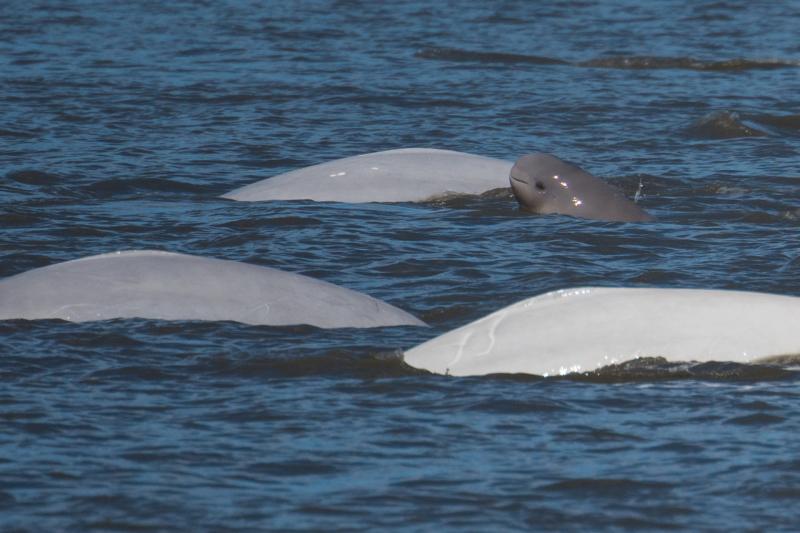Today, NOAA Fisheries announced an updated abundance estimate for endangered Cook Inlet beluga whales. Scientists estimated that the population size is between 290 and 386, with a median best estimate of 331. In 2018, scientists estimated that the population size was between 250 and 317, with a median estimate of 279.
Given the overlap in the range estimates, scientists cannot definitively say that the population increased from 2018 to 2022. However, an analysis of population trends for the most recent 10-year period suggests that the population may have increased slightly (0.2 percent per year). (The analysis looked at 2012–2022, excluding 2020 when the survey was canceled due to COVID and 2021 when survey coverage was limited due to poor weather.)
“While this is certainly encouraging news, it is important to recognize that abundance estimates can vary from year to year due to a number of factors,” said Kim Goetz, marine mammal biologist, Alaska Fisheries Science Center.
For instance, after the 2018 survey, results showed a 2.3 percent decline from 2008–2018 in population abundance. Scientists suspect that decline could have been part of a natural oscillation in the population or possibly due to impacts of the unprecedented heatwave in the Gulf of Alaska during the same time period.
During the 1960s, 70s, and early 80s, the Alaska Department of Fish and Game conducted a number of aerial surveys that covered parts of Cook Inlet. The surveys documented distribution and numbers of beluga whales. The highest estimate of 1,292 Cook Inlet beluga whales reported during these surveys was based on counts made in August 1979.
Understanding Beluga Population Variability
Abundance estimates can vary due to a variety of factors including:
- Births and deaths
- Changes in beluga behavior
- Changes in beluga distribution
- Natural and human-caused impacts
- Random variability in the data
NOAA Fisheries continues to make improvements to its data collection and abundance estimate methodology for Cook Inlet Beluga whales. In 2018, the scientific team implemented an improved methodology to estimate group size and to evaluate all data collected since 2004.
This approach allowed scientists to estimate Cook Inlet group sizes for both the June 2021 and 2022 survey while accounting for visibility bias:
- Availability bias due to diving behavior
- Proximity bias due to individuals concealed by another individual in the video data
- Perception bias due to individuals not detected because of small image size in the video data
- Individual observer bias in visual observer data
Estimating Cook Inlet Beluga Abundance
NOAA Fisheries has been conducting aerial surveys of Cook Inlet beluga whales to estimate the population’s abundance for more than two decades.
From a small airplane, scientists look for and count groups of beluga whales and record video of the whale groups.
They then analyze the video and observer counts to produce a broad-scale picture of the whales’ distribution and abundance in the inlet in early June.
The population estimate is incorporated into the Cook Inlet beluga whale stock assessment. In accordance with the U.S. Marine Mammal Protection Act, marine mammal stock assessments are reviewed by an independent panel of experts, the Alaska Scientific Review Group. Marine mammal stock assessments are also made available as drafts for public review before being finalized.
Species in the Spotlight and 50th Anniversary of the Endangered Species Act
The Cook Inlet stock is one of five beluga populations recognized within U.S. waters. NOAA Fisheries listed Cook Inlet beluga whales as endangered under the Endangered Species Act in 2008, and designated Critical Habitat for the species in 2011. We finalized a recovery plan for Cook Inlet beluga whales in December 2016.
Cook Inlet beluga whales are also one of NOAA Fisheries' Species in the Spotlight—an initiative that includes species considered most at risk for extinction and prioritizes efforts for their recovery. The 2021–2025 Priority Action Plan for the Cook Inlet beluga outlines actions that are needed in the next 5 years to address the most urgent threats to the species. The next population abundance survey for Cook Inlet beluga whales is scheduled for June 2024.
In 2023, NOAA Fisheries is celebrating the 50th anniversary of the Endangered Species Act, a major milestone for the conservation of protected species and their habitats. Through advanced scientific knowledge, improved technology and tool development, and strong collaborations with innovative partners, we have made significant strides in slowing down or reversing the population decline of endangered and threatened species.



